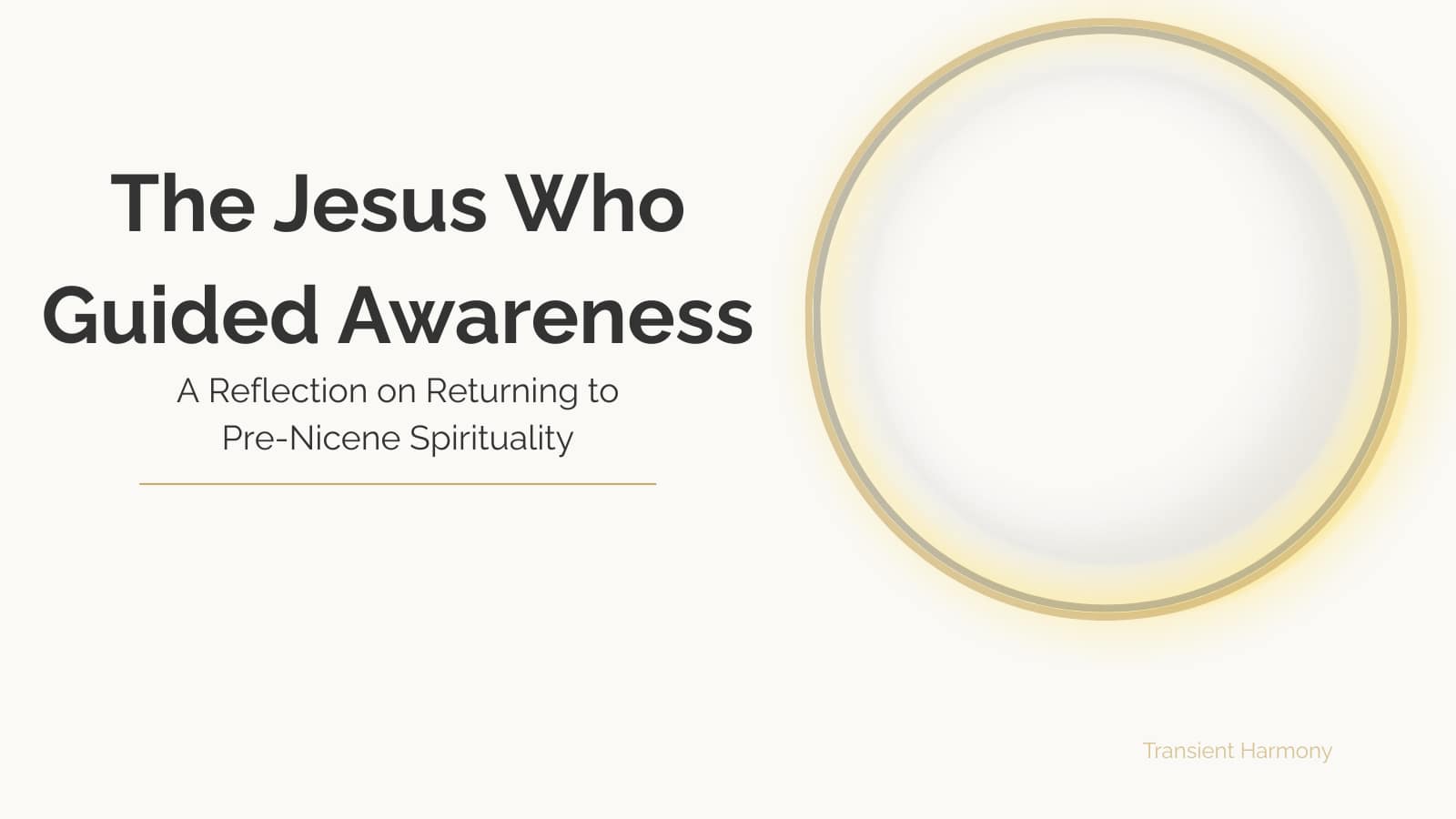This reflection is a personal meditation written through the lens of Transient Harmony. It is not presented as doctrine or theology, but as one traveler’s contemplation on how the teachings of Jesus continue to illuminate the path of awareness and love. Readers of any or no faith are invited to take what resonates, release what does not, and simply travel with the idea for a while.
A return to pre-Nicene spirituality: the Jesus who guided awareness rather than legislated belief.
The Jesus Who Guided Awareness
A Reflection on Returning to Pre-Nicene Spirituality
by Braddon Damien White
There’s a quiet difference between believing and awakening. Belief can be inherited, taught, or legislated. Awakening must be lived.
When I reflect on Jesus—not the figure later defined by councils or preserved in hierarchies of doctrine, but the living teacher who walked beside others in dust and sunlight—I see not an organizer of religion but a guide of awareness. His presence, as remembered through fragments and echoes, feels less like command and more like invitation.
He spoke to the soul, not the system. To the spark of light within each person.
Before the Church, There was the Teacher
The Christianity we know today took its recognizable form in the fourth century, when a gathering of men decided which writings to keep, how to define belief, and what it meant to belong. Councils gave shape and borders to what had once been fluid, mystical, and participatory.
But before those decisions—before creeds and canon—there was a movement of consciousness. People were not joining an institution; they were responding to an awakening.
Jesus didn’t found a church. He didn’t build walls or hierarchies. He walked among those in need, sharing parables that stirred remembrance rather than obedience. His way of teaching asked each person to look inward—to rediscover the divine source already theirs.
In that sense, he wasn’t creating followers so much as fellow travelers.
The Core Message: Love, Light, and the Inner Kingdom
Across both canonical and non-canonical texts, a consistent voice emerges:
The kingdom of God is within you.
Love one another as I have loved you.
Let your light shine before others.
These are not edicts. They are awakenings of remembrance—gentle reminders that divinity is an interior reality, not an external prize.
His message was less about reaching upward and more about turning inward: to live from the eternal essence that animates all mortal life. To find God not above the world but within it. To embody love as the living form of awareness itself.
The Fourth-Century Shift
By the time of Constantine, spirituality had become entwined with empire. The great councils codified theology and decided which writings were sacred and which were heretical. The fluid, plural voices of early spirituality—including many contemplative texts—were pushed to the margins.
The living teacher became a distant deity. Revelation became creed. Experience yielded to authority.
It’s not that the Church’s formation was without purpose; order often arises from chaos. But something subtle was lost: the direct, participatory relationship between the soul and the divine.
To return to pre-Nicene spirituality is not to undo history, but to reclaim essence—to remember that Jesus’ path was about consciousness, not control; illumination, not legislation.
The Celestial and the Mortal
In the language of Transient Harmony, Jesus recognized the unity of the celestial soul and the mortal expression. His words often point toward a self that is both eternal and embodied:
I and the Father are one.
Before Abraham was, I am.
In my Father’s house are many dwelling places.
Read through a participatory lens, these speak to a continuity of consciousness—the awareness that the same divine essence that breathed life into the cosmos breathes life into us.
He lived as that awareness. He taught from it. Healing and compassion flowed naturally from seeing others not as separate beings, but as expressions of the same luminous source.
That is the heart of Transient Harmony: bridging the eternal and the ephemeral—understanding that divinity does not visit us from beyond, but radiates through us from within.
The Return to Living Light
To “return to pre-Nicene spirituality” is not about nostalgia or rebellion. It is about recovering the living pulse of awareness that religion once sought to preserve but often forgot how to embody.
It is the quiet turning inward to find the same light that Jesus spoke of—not as dogma, but as direct experience. It is the courage to love without condition, to act from unity rather than fear, and to see all of life as sacred movement.
In a way, this return is not backward at all. It is forward—a step toward integration, where ancient knowing meets modern consciousness.
The invitation remains: not to worship awareness, but to become aware. Not to recite truth, but to live it.
The Living Thread
I hold deep respect for the many paths people walk—including the Christian path as it has evolved through history. My own soul resonates with the Jesus who guided awareness rather than legislated belief.
The teacher who said, in essence: You are not separate from the divine; you are its unfolding expression.
In this reflection, I don’t seek to redefine him—only to remember him through the same lens I view all things: the meeting point of the eternal and the ephemeral, the stillness and the motion, the soul and the life.
We travel together for a while, and then we part—each carrying a spark of that same living light.
That is the Jesus I know.
The one who built no church, but opened every heart.
The one who taught that awareness itself is the kingdom of heaven.
